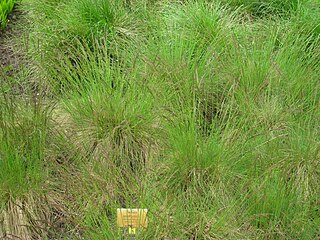
Ornamental grasses are grasses grown as ornamental plants. Ornamental grasses are popular in many colder hardiness zones for their resilience to cold temperatures and aesthetic value throughout fall and winter seasons.

Festuca (fescue) is a genus of flowering plants belonging to the grass family Poaceae. They are evergreen or herbaceous perennial tufted grasses with a height range of 10–200 cm (4–79 in) and a cosmopolitan distribution, occurring on every continent except Antarctica. The genus is closely related to ryegrass (Lolium), and recent evidence from phylogenetic studies using DNA sequencing of plant mitochondrial DNA shows that the genus lacks monophyly. As a result, plant taxonomists have moved several species, including the forage grasses tall fescue and meadow fescue, from the genus Festuca into the genus Lolium, or alternatively into the segregate genus Schedonorus.

Festuca ovina, sheep's fescue or sheep fescue, is a species of grass. It is sometimes confused with hard fescue.
British NVC community MG12 is one of the mesotrophic grassland communities in the British National Vegetation Classification system. It is one of three types of mesotrophic grassland classified as grass-dominated inundation communities.

Festuca pratensis, the meadow fescue, is a perennial species of grass, which is often used as an ornamental grass in gardens, and is also an important forage crop.

Festuca rubra is a species of grass known by the common name red fescue or creeping red fescue. It is widespread across much of the Northern Hemisphere and can tolerate many habitats and climates. It is best adapted to well-drained soils in cool, temperate climates; it prefers shadier areas and is often planted for its shade tolerance. Wild animals browse it, but it has not been important for domestic forage due to low productivity and palatability. It is also an ornamental plant for gardens.
Colpodium is a genus of plants in the grass family, native primarily to Asia but with a few species on certain mountains in Africa.

Festuca californica is a species of grass known by the common name California fescue.

Festuca idahoensis is a species of grass known by the common names Idaho fescue and blue bunchgrass. It is native to western North America, where it is widespread and common. It can be found in many ecosystems, from shady forests to open plains grasslands.

Tussock grasses or bunch grasses are a group of grass species in the family Poaceae. They usually grow as singular plants in clumps, tufts, hummocks, or bunches, rather than forming a sod or lawn, in meadows, grasslands, and prairies. As perennial plants, most species live more than one season. Tussock grasses are often found as forage in pastures and ornamental grasses in gardens.

Gavojdia is a commune in Timiș County, Romania. It is composed of four villages: Gavojdia, Jena, Lugojel and Sălbăgel.

Simyra albovenosa, the reed dagger, is a moth of the family Noctuidae. It is found in most of Europe, then Turkey, Iran, Transcaucasus and into the east Palearctic.

Lake Nemrut is a freshwater crater lake in Bitlis Province, eastern Turkey. It is part of Nemrut Caldera, a volcanic caldera atop Volcano Nemrut. The government of Turkey has named as its 14th Wetland of International Importance the Nemrut Caldera. With its structural morphology that is unique in Turkey, the site qualifies for the Ramsar List under Criterion 1 on "representative, rare, or unique examples of a natural or near-natural wetland type found within the appropriate biogeographic region".

Festuca amethystina is a species of true grass (Poaceae) native to Europe, including Turkey.

Festuca gigantea, or giant fescue, is a plant species in the grass family, Poaceae. Because this and other members of Festuca subgenus Schedonorus have more in common morphologically with members of the genus Lolium than with Festuca and often produce fertile hybrids with other Lolium species, Festuca gigantea has been recently published as Lolium giganteum(L.) Darbysh. (1993) and then as Schedonorus giganteus(L.) Holub (1998). Sources vary as to which placement is more acceptable.
Festuca baffinensis also called the Baffin Island fescue is a species of grass in the Poaceae family. The name was published in Bulletin of the National Museum of Canada in 1940. The specific name 'baffinensis' was named after Baffin Island in canada. This species is native Subarctic Northern Hemisphere to W. Central U.S.A. Festuca baffinensis is a perennial plant and mainly grows in temperate biomes or volcanic areas.
Festuca brunnescens is a species of grass in the family Poaceae. The species was first published in 1976. Festuca brunnescens is perennial and mainly grows in temperate biomes. This species is native to Iran, North Caucasus, Transcaucasus and Turkey.
Festuca djimilensis is a species of grass in the family Poaceae. This species is native to North Caucasus, Transcaucasus, and Turkey. Is perennial and prefers temperate biomes. Festuca djimilensis was first described in 1874.
Festuca drymeja is a species of grass in the family Poaceae. This species is native to Albania, Algeria, Austria, Bulgaria, Czechoslovakia, Greece, Hungary, Iran, Italy, Morocco, North Caucasus, Poland, Romania, Sicilia, Transcaucasus, Tunisia, Turkey, Turkey-in-Europe, Ukraine, and Yugoslavia. Its perennial and prefers temperate biomes. Festuca drymeja was first described in 1823.












